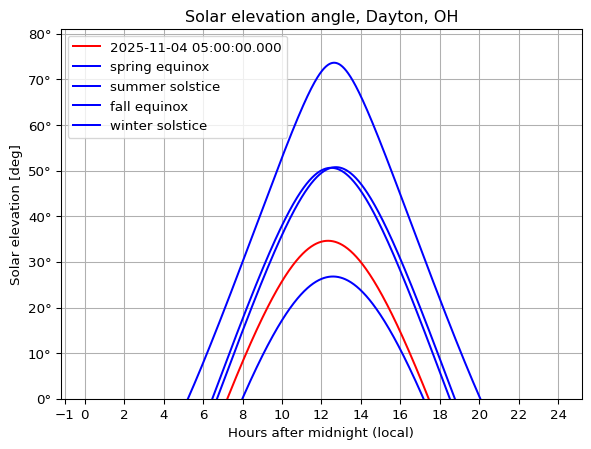from astropy.coordinates import EarthLocation, get_sun, AltAz
from astropy.time import Time
from astropy import units as u
from astropy.visualization import quantity_support, time_support
from matplotlib import pylab as plt
import matplotlib.dates as mdates
import numpy as npCompute solar elevation angles
Select the location and time.
#llh = np.array([34.73,-86.58,195]) # deg, deg, meter - Huntsville
location_name = "Dayton, OH"
llh = np.array([39.76,-84.19,226]) # deg, deg, meter - Dayton
pos = EarthLocation(lat=llh[0],lon=llh[1],height=llh[2])
utcoffset = -5 * u.hour # EST
local_midnight = Time("2025-11-04 00:00:00") - utcoffsetdelta_midnight = np.linspace(0, 24, 1000) * u.hour
times = local_midnight + delta_midnight
frame = AltAz(obstime=times, location=pos)
sunaltazs = get_sun(times).transform_to(frame)
alts = sunaltazs.alt
spring_equinox = Time("2025-03-21 00:00:00") - utcoffset
summer_solstice = Time("2025-06-21 00:00:00") - utcoffset
fall_equinox = Time("2025-09-21 00:00:00") - utcoffset
winter_solstice = Time("2025-12-21 00:00:00") - utcoffset
specdates = [spring_equinox,summer_solstice,fall_equinox,winter_solstice]
specnames = ["spring equinox","summer solstice","fall equinox","winter solstice"]
with quantity_support():
fig, ax = plt.subplots()
#ax.xaxis.set_major_formatter(mdates.DateFormatter('%H'))
locator = mdates.AutoDateLocator(maxticks=20)
ax.plot(delta_midnight, sunaltazs.alt,'r',label=f'{str(local_midnight)}')
ax.xaxis.set_major_locator(locator)
ax.grid()
for sd,sn in zip(specdates,specnames):
times = sd + delta_midnight
frame = AltAz(obstime=times, location=pos)
saz = get_sun(times).transform_to(frame)
ax.plot(delta_midnight,saz.alt,'b',label=sn)
ax.legend()
ax.set_title(f'Solar elevation angle, {location_name}')
ylim = np.array(ax.get_ylim())
ylim[0] = 0.0
ax.set_ylim(ylim)
ax.set_xlabel('Hours after midnight (local)')
ax.set_ylabel('Solar elevation [deg]')
